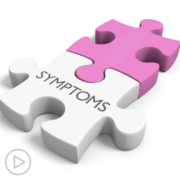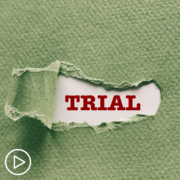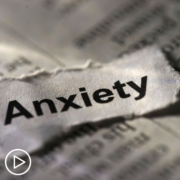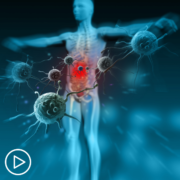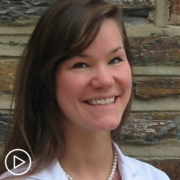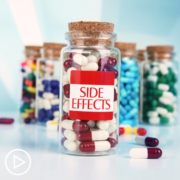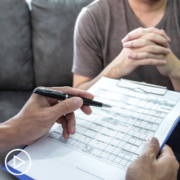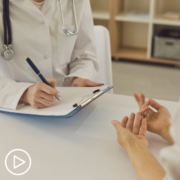Thriving With CLL | Tips and Support for Navigating Care from Patient Empowerment Network on Vimeo.
What are the key elements that help patients thrive with chronic lymphocytic leukemia (CLL)? In this webinar, Dr. Seema Bhat discusses CLL treatment and research, explains how the side effects and symptoms of CLL are managed, and shares tools for managing daily life with CLL.
Seema Bhat, MD is a hematologist at The Ohio State University Comprehensive Cancer Center – The James. Learn more about Dr. Bhat.
See More from Thrive CLL
Related Resources:
Transcript:
Katherine:
Hello, and welcome. I’m Katherine Banwell, your host for today’s program. Today’s webinar is part of our Thrive series, and we’re going to discuss tools for navigating life with CLL. Before we get into the discussion, please remember that this program is not a substitute for seeking medical advice. Please refer to your healthcare team about what might be best for you.
Let’s meet our guest today. Joining us is Dr. Seema Bhat. Dr. Bhat, welcome. Would you please introduce yourself?
Dr. Bhat:
Hi, Katherine. Thank you for having me here on the program. My name is Seema Bhat, and I am an associate professor at Ohio State University with expertise in treating CLL.
Katherine:
Excellent, thank you so much for taking time out of your schedule to join us.
Dr. Bhat:
You’re welcome.
Katherine:
Like all of the webinars in our Thrive series, we start with this question. In your experience, what does it mean to thrive with CLL?
Dr. Bhat:
So, thriving with CLL to me means that we envision our patients with CLL leading normal, functional, and productive lives. You know, when patients hear the word “cancer,” or “leukemia,” it comes as a big shock to them. Cancer is also associated with drastic changing – life-changing experiences. Patients think about their shortened life span, and the difficulties they’ll have to endure in this shortened life span due to the treatments they will be needing for their cancer. But I want to tell my patients that even though they have a leukemia, they have a cancer, they can still focus on their life in general.
They have – this has been made possible by very effective yet gentle treatments approved for CLL. Patients can have an enjoyable, fulfilling life focusing on their life in general, and thrive.
Katherine:
Thank you for that, Dr. Bhat. That’s important for patients to know. Let’s move on to treatment and walk through CLL treatment classes and types. Some of our audience members may already know this information, but it’s a good baseline for newly diagnosed patients. First, CLL patients are often put in “watch and wait” when they’re first diagnosed. What does that mean?
Dr. Bhat:
So, “watch and wait” means observation. CLL is a slow-growing cancer, generally, and one of the few cancers that’s managed by observation if it’s not causing any problems to the patient. These problems could include symptoms in the form of fatigue, unintentional weight loss, symptomatic enlargement of their lymph nodes or spleen, or we could see changes in their blood work in the form of decreased hemoglobin or decreased platelets.
If this is not happening, observation is still the standard of care. And data from this comes from a number of clinical trials where patients were treated based on just having the disease without having any of the symptoms or signs I just mentioned.
All these studies had negative results, meaning that starting treatment at diagnosis did not affect the overall survival of these patients. These patients – these studies were, however, done in chemoimmunotherapy era. Now, we have targeted agents. And also, now we are able to define CLL better, which means that we are able to predict who has higher risk disease.
So, there’s renewed interest in these – what these are called, early intervention studies. But until we have those results are matured and available, “watch and wait” is still the standard approach. And during “watch and wait,” we see patients at regular intervals, we assess them for symptoms, we look at their bloodwork, and one of the main reasons for seeing these patients at regular intervals is to reinforce what symptoms we want them to pay attention to. So, educating patients at each visit is a very important part of these visits.
“Watch and wait” may be all that 1/3 of our patients may need through their lifetime. They may never need any CLL-directed treatment.
Katherine:
Dr. Bhat, when it’s time to start therapy, what types of treatments are available for CLL patients?
Dr. Bhat:
So, when we think about treatment for cancer, we think about chemotherapy – the conventional chemotherapy that’s associated with side effects like hair loss, nausea, or vomiting. I’m very happy to say that conventional chemotherapy is no longer the standard of care for patients with CLL. Patients who need treatment for CLL are nowadays treated with what are called, “targeted agents.”
And we have, in general, two different classes of targeted agents that have been approved for treatment for CLL. We have the BTK inhibitors, Bruton’s tyrosine kinase inhibitors, of which we have three. We have ibrutinib (Imbruvica), we have acalabrutinib (Calquence), and we have zanubrutinib (BGB-3111). Then we have BCL-2 inhibitors, of which we currently have one approved, of which is called venetoclax (Venclexta). These treatments can be combined with monoclonal antibodies, which are directed towards the antigen called CD20. For example, rituximab (Rituxan) or obinutuzumab (Gazyva).
Typically, venetoclax is combined with monoclonal antibody as a time-limited therapy. BTK inhibitors usually are not combined with monoclonal antibody.
Katherine:
What about stem cell transplant, does that fit in there?
Dr. Bhat:
So, stem cell transplant still has a role for treatment of patients with CLL, but it has moved down the line with such highly effective and well-tolerated oral agents available.
But, for refractory patients – what we call dual-refractory patients, we definitely are, especially in high – patients who have higher risk features, we do refer them to stem cell transplant.
Katherine:
And what is a dual-refractory patient, exactly?
Dr. Bhat:
Dual-refractory patients mean patients who have had a BTK inhibitor, be it ibrutinib, acalabrutinib, or zanubrutinib, and the disease has progressed on that. And then we give them venetoclax, which is a BCL-2 inhibitor. So, these are the two classes of targeted agents that we have available. If they have received ibrutinib, acalabrutinib, or zanubrutinib, and after that, a venetoclax, or venetoclax followed by a BTK inhibitor, and the disease has progressed on both. These patients are called dual-refractory, and currently they tend to be very resistant to whatever treatments we have available. And we looked at other modalities of treatment, be it clinical trials or stem cell transplants for that.
Katherine:
How are targeted therapies administered?
Dr. Bhat:
So, most of the targeted therapies that we have, we are happy to say that these are oral agents. The BTK inhibitors, the three that we have available, are oral agents. Ibrutinib is taken once a day, zanubrutinib and acalabrutinib are twice a day. Venetoclax, similarly, is an oral agent and is taken once a day. Monoclonal antibodies are also considered targeted agents. These are given as infusions in the clinic or in the clinician’s office.
Katherine:
The oral medications, patients take that at home? They don’t have to go into the hospital?
Dr. Bhat:
They do not have to go into the hospital. However, venetoclax is associated with a specific side effect called, “tumor lysis syndrome,” where this medication works so well that initially the cells with die off quickly and then things can collect in the blood.
For example, uric acid can go up, electrolytes can be up, any number can go up. So, we monitor what those initial weeks of starting venetoclax, we monitor patients very closely. We have them come back and forth to the clinic for monitoring, bloodwork, maybe hydration. And sometimes, if we think they’re at a very high risk for this tumor lysis syndrome, we admit them to the hospital.
Dr. Bhat:
After we cross that, those are administered at home. They can take these at home.
Katherine:
Dr. Bhat, where do clinical trials fit into treatment?
Dr. Bhat:
So, clinical trials play a very important role to advance treatments. Clinical trials for CLL are done to test new treatments, new combinations of treatments, compare different treatments to each other. The goal of these clinical trials is to continue to do better than what we currently have available. This is how treatments improve. Despite all the advancements that we have had in CLL, in the recent years, it continues to be an incurable disease, even today. Our goal as researchers is never to stop until we get to that cure, and clinical trial is that pathway to that cure.
Katherine:
Are there emerging therapies that are showing promise?
Dr. Bhat:
Yes, of course. There are a number of emerging therapies that are showing promise. So, we all know about ibrutinib and other BTK inhibitors. These work very well, but sometimes the disease can get resistant to these medications, meaning that it stops responding to these treatments. We are excited about this new kind of BTK inhibitor called pirtobrutinib which has shown great promise in these resistance cases, and we are hopeful that it’ll be approved soon.
Katherine:
Are there other options that patients have?
Dr. Bhat:
So, we all hear about what is called, “chimeric antigen receptor T-cell therapy,” or CAR-T therapy. This is studied under clinical investigation for CLL and looks very promising. The therapy uses the person’s own immune cell called, “T cell” to identify and attack cancer cells.
T cells are taken from the patient’s blood and sent to a specific lab. There, the cells are modified so that they can better find and attack cancer cells. These modified T cells are then re-injected back into the patient to find and fight that cancer, to eradicate the disease. So, this looks very promising.
Katherine:
Many CLL community members are interested in learning more about their disease. So, for newly diagnosed patients, what are a few educational resources you recommend to help them learn more about their condition?
Dr. Bhat:
There are a number of well-established support groups or educational resources for our patients. These include the CLL Society, The Leukemia & Lymphoma Society, Lymphoma Research Foundation, and then we have Patient Empowerment Network, and we have Patient Power. All these resources provide support groups, organize webinars, and have educational material for our patients.
Katherine:
What about patients who have been living with CLL for many years, or are quite knowledgeable about their disease? Are there more advanced resources for patients to stay up to date on the latest research and treatment?
Dr. Bhat:
So, for patients who want to search for additional resources, especially looking for clinical trials, going on this website called clinicaltrials.gov, they can first search for CLL-related clinical trials. Also, NCCN, or “National Comprehensive Cancer Network,” has patient resources for each disease, and then they can find information on CLL there, also. I would also like to say that Google is a good resource, as long as you know where it is taking you.
Katherine:
Exactly. You may not be able to rely on everything you find.
Dr. Bhat:
Right.
Katherine:
Yeah. Many people with CLL will experience fear and anxiety, whether it’s the stress of being in “watch and wait” or worrying about regression. Why do you feel it’s important for patients to share how they’re feeling with their healthcare team?
Dr. Bhat:
So, one of the important things to know about CLL is that CLL, at this point of time, it’s not a curable disease. It is a lifelong disease. Patients will have to deal with CLL for the rest of their life in some form or other, either on watchful waiting, or on active treatment, or if they’ll complete a treatment, they’ll have this lurking fear of relapse at any time. A large part of what I do is to help my patients understand what it means to live with CLL. And, of course, anxiety is a big part of that living with CLL.
Although at this time, we’re unable to cure our patients with CLL, I want my patients to understand that it’s very treatable, treatments are very well-tolerated with low toxicity, and patients live a long life. They can have good, productive, and active life. They should ask their care team about resources for social, emotional, and physical support.
They should let them know about their concerns, talk about their feelings.
Katherine:
That’s my next question, actually. How can a social worker provide support and are there other healthcare team members who might be able to help?
Dr. Bhat:
So, yes, patients are on a rollercoaster – emotional rollercoaster with this diagnosis. With this diagnosis come lots of unknowns. Worries about possible shortened life span, anxiety over treatment, and effects of treatment. So, there’s lots to deal with, and lot of uncertainty, which causes a feeling of hopelessness for these patients. So, psychological support is very important. That’s where the role of social worker comes in.
We get them involved to help patients deal with the diagnosis, and social workers – they can provide patients with tools to cope with this life-changing event. They use life tools like encouraging positive thinking, mindfulness, being aware of what the patient can control involving faith and family, and also involving self-care.
That’s where we see the role of the whole team as such. If patients are having more difficulties, we can have other members of a team, like a mental health provider, connect with our patients. Social workers and other members of the team can help our patients get connected to support groups, or even to other patients who have had similar experiences.
Katherine:
What about worry and anxiety related to COVID and compromised immunity? What would you like patients to know?
Dr. Bhat:
So, COVID has become another source of anxiety, unfortunately, for many of our patients, and rightly so. Our patients with CLL are considered immunocompromised, meaning that their immune systems do not work that well, which makes these patients very susceptible to different kinds of infections, COVID being one of them. And this was actually shown by some of the early COVID-related studies that showed a very high mortality in patients with CLL.
This has improved now, mostly because now we are better equipped to handle COVID. We have COVID-directed medications available, but the major impact has been made by the vaccines. So, we highly encourage our patients to get vaccinated against COVID and keep up to date with the latest CDC guidelines. Also, we have Evusheld available, which is under emergency use authorization, and our patients with CLL, due to their weaker immune system, are eligible to get this, which adds an extra layer of protection for our patients.
Also, it’s important to know that our test – if our patients test do test positive for COVID, they should let their team of doctors know immediately, since now we have monoclonal antibodies and pills that can be used to treat symptomatic COVID.
Katherine:
That’s great information, thank you. Financial concerns can be another source of stress for people with CLL. Obviously, everyone’s situation is different, of course, but what resources are available for patients who need financial support?
Dr. Bhat:
So, financial barriers can be a real concern for our patients. Targeted therapies are very expensive, and although insurances do cover them, the approved FDA drugs, copays can be very high, and this adds on because our patients with – our treatments with CLL, some of them tend to be indefinite. That means patients have to take those medications on an ongoing basis, and when they face such situations, high copays, we look into financial assistance. We look for funding for copay assistance, and funding can be provided by pharmaceutical companies. We can also apply for grants through The Leukemia & Lymphoma Society and other resources to help out our patients with these financial concerns.
Katherine:
So, does the patient work with the healthcare team to find financial support?
Dr. Bhat:
Absolutely. We at our institution have what is called, “MAP,” or Medication Assistance Program.
And when we see that – we run the medications through the insurance, then we see the copay is high, we refer our patients to the MAP program, and then they take over. They find them grants, they find them assistance through be it pharmaceuticals, copay assistance programs. So, invariably, almost all patients who come and see us are helped through that program.
Katherine:
What about a nurse navigator or patient navigator? What do they do? How can they help?
Dr. Bhat:
Well, so yes. Nurse navigators and patient navigators are also very important for caring for our patients. So, patients can have, besides our care for our patients which includes caring for their disease, caring for their symptoms, caring for their reduced hemoglobin and reduced platelets, our symptom management, they have psychological needs, they have functional needs, they have needs like family support.
So, these are all the things that patient navigators can help patients set that up based on their – we have patients who travel from out of state, are from two or three hours away. So, these patient navigators look into what resources they should have available locally. Sometimes, patient navigators help us – some patients cannot do frequent travels back and forth, so we get them connected to local oncologists, also. So, patient navigators look into those appointments, look into those offices, so they provide a lot of help to us manage our patients. So, they provide more of a holistic management, rather than just treatment of CLL.
Katherine:
Let’s answer a few audience questions that we received in advance of the webinar. This one is from William. Can you please talk about common side effects of CLL – which, of course, we’ve covered already, but both the ones from the disease itself and then ones related to treatment, and what can be done about these?
Dr. Bhat:
So, disease-related side effects, or we call them disease-related symptoms, include fatigue as a common symptom. Unintentional weight loss can happen. Fevers, chills, or drenching night sweats can happen. We call them, “B symptoms.” Spleen can enlarge, and the enlargement can cause belly pain or feeling of fullness quickly after a meal since spleen is close to our stomach, and as it enlarges, it limits the space stomach can take up in the belly. Lymph nodes can enlarge and can get uncomfortable. So, if any of these symptoms happen, then we have to treat the CLL, and once we start treating the CLL these symptoms should go away.
As far as treatment-related side effects are concerned, for example, BTK inhibitors are associated with a certain set of side effects. For example, patients can have muscle cramping, muscle pain, joint pain. Patients can have diarrhea. Some of the side effects that we worry about is change in heart rhythm, for example, atrial fibrillation. We talked about that, or increased risk of bleeding.
Those are some of the side effects we worry about, and if those were to develop, then, of course – for example, a patient has atrial fibrillation, and if it’s symptomatic, we hold the medication. We take care of the atrial fibrillation, usually in collaboration with cardiologists, and once that’s under control, then we have to decide what to do with the treatment. If the atrial fibrillation is under control, we can re-initiate the treatment, or we can go to one of the next-generation BTK inhibitors – the acalabrutinib, the pirtobrutinib, which have less of those side effects.
Bleeding tends to be a concern, but anything that reduces the risk of bleeding like other medications, aspirin, clopidogrel (Plavix), other blood thinners, we can avoid them, monitor these patients very closely for any of these side effects, so that’s critical. With venetoclax, it’s usually very well-controlled. It’s the initial part of treatment that tends to be a little bit intensive because of the specific side effect called, “tumor lysis syndrome,” which means that the drug works very quickly, and cells die off quickly, they can release stuff in the blood, and things can collect in the blood.
Uric acid can go up, electrolytes can be up, any number can go up. So, we are aware of this side effect, and we actually pre-emptively have things in place that can prevent this from happening, or if it happens, we manage it right away. For example, venetoclax has a specific dose initiation. For example, it’s called, “dose ramp-up.” We start it at a lower dose, 20 milligrams, for one week. Escalate it to 50 the next week, 100 the third week, 200 fourth week, and 400 the last week, which is the standard dose. They continue on 400 from there onward.
And even with the slow dose escalation, in the early couple of weeks, we monitor them very closely. Once we initiate a dose, we bring them back to the clinic to recheck their blood work to see if there are any changes. If any changes have happened, we hydrate them, initiate medication for their tumor lysis syndrome.
If the risk of tumor lysis is very high, then we monitor then admit them to the hospital. Otherwise, long-term side effects of venetoclax, what we have noticed mostly is gastritis, most side effects – mostly diarrhea. But that’s usually well-controlled. We can manage it well with supportive care.
Katherine:
Here’s another question from Anna. She asks, “What is MRD, and does that mean that the disease is cured?”
Dr. Bhat:
So, MRD is minimal residual disease, and in CLL is defined as the number of leukemic cells that can be detected in the blood or bone marrow following treatment, meaning how many cancer cells are remaining after treatment? This can be checked by a couple of tests. Most commonly, we use flow cytometry. Undetectable MRD is currently defined as the presence of less than one cell – one CLL cell in 10,000 white cells.
It’s emerging as an endpoint in a number of clinical trials, and presence of no MRD, also called, “MRD-negative status,” although not considered a cure, predicts better outcomes with longer remission. This is being done in combination treatment, and although it’s part of clinical trials currently, with more data available, we may start using this in clinical practice in the next coming years.
Katherine:
Sophia wants to know, “Are there any clinical trials regarding Richter’s, or DLBCL, transformation?”
Dr. Bhat:
So, Richter’s transformation means when CLL, which is a low-grade disease, changes into high-grade lymphoma, and most commonly it’s “diffuse large B-cell lymphoma,” or DLBCL. Currently available treatments for Richter’s transformation are, unfortunately, sub-optimal. So, clinical trials to find better treatments are critical for this division, and there are a number of these currently going on. For example, some trials add targeted agents to the backbone of standard chemotherapy called, “R-CHOP.”
So, we have one trial where acalabrutinib is being added. There’s another clinical trail where venetoclax is being combined with R-CHOP. One of the problems with Richter’s Transformation is that it tends to be refractory to treatment, and it tends to come back or relapse. So, there are studies ongoing for relapse treatment as well, with combination of targeted agents. And CAR-T therapy, we just talked about that, is also being studied in Richter’s Transformation. So, there’s a lot going on to improve the outcome for this.
Katherine:
Okay, that’s great. Here’s one from Phil, “How do mutations affect longevity when surviving CLL? What new treatments help with P53 mutation?”
Dr. Bhat:
So, there are certain prognostic markers for CLL, meaning certain tests that can tell us how a particular patient is expected to do. Some of these tests detect presence or absence of mutations in certain genes. For example, the IGHV gene can be mutated or unmutated.
In patients with mutated IGHV, they do well, and patients with unmutated IGHV tend to have a more aggressive disease and may require treatment sooner. Similarly, TP53 mutations also tend to require treatment sooner, and more of these mutations do not respond well to conventional chemotherapy. However, targeted therapy has changed the outlook for these mutations, and it works very well for both these mutations.
Katherine:
Finally, our last question. One audience member would like to know more about how CLL affects the immune system, including wound healing, and how does CLL impact this?
Dr. Bhat:
So, patients with CLL usually have a weaker immune system. The lymphocyte, which is the white cell, which is affected in CLL, is an important part for an immune system, and due to the presence of disease, these lymphocytes – although there are lots of them in patients with CLL, they tend to be non-functional.
“Functionally incompetent,” that’s what they’re called. And it leaves the patient’s immune deficient and susceptible to a variety of infections. Also, the lymphocyte is component – the B lymphocyte is one component of immune system. There are other components like T lymphocyte, antibody, MK cell. There’s cross-dock between the B cells and what we call, the “microenvironment,” which is made of the T cells. This cross-dock is deficient in patients with CLL, again making them immune-deficient and susceptible to infection. So, that’s one impact on their immune system.
Sometimes, there’s something else happening in the immune system where the immune system can go crazy, or wacky, and start attacking the patient’s own blood cells leading to, for example, decrease of hemoglobin or platelets, because these are immune complications. And also, due to a weak immune system, patients with CLL can have delayed wound healing, which also predisposes them to infection.
So, being aware of these complications is important and using appropriate precautions can be very helpful. Again, because they have a weakened immune system, vaccines are very important. Using all measures to avoid infection, hand washing, staying away from patients, from people who are obviously sick, is very important. Sometimes, patients where we see they’re’ getting frequent infections, we can use what’s called, “IVIG,” intravenous immunoglobulin. These are pre-farmed antibodies which are injected into or infused into the patient at regular intervals before the sixth week, which reduce the chance of these infections.
Katherine:
Thank you, Dr. Bhat, for all the information. And please continue to send in your questions to question@powerfulpatients.org, and we’ll work to get them answered on future programs. Dr. Bhat, as we close out our conversation, I’d like to get your thoughts on where we stand with CLL progress. Can patients truly thrive with CLL?
Dr. Bhat:
So, we have made strides in CLL treatment in the past 10 years that really changed the lives of our patients. These treatments work extremely well, and the side effects are gentler than what we used to see with conventional chemotherapy. And it’ll continue to get better with ongoing research, so I will tell our patients to focus on their lives. We know that they have this disease, but we know how to control it well. So, live your life. Enjoy. Be assured that we have all the tools available for you so that you can thrive.
Katherine:
Yeah. It seems like there’s a lot of hope in the field. Thank you so much for joining us today, Dr. Bhat. It’s been a pleasure.
Dr. Bhat:
Thank you so much for having me.
Katherine:
And thank you to all of our partners. To learn more about CLL and to access tools to help you become a proactive patient, visit powerfulpatients.org. I’m Katherine Banwell. Thanks for joining us today.


